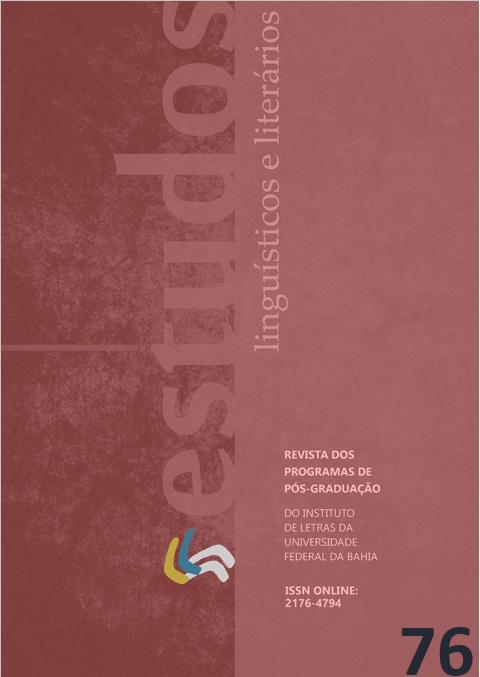PRESENCE OF QUECHUA AND TAHUANTINSUYU IN AMAZONIAN LITERATURE
THE HARAWINCHIS COLLECTION
DOI:
https://doi.org/10.9771/ell.v0i76.53139Keywords:
Quechua; Amazonian literature; Contemporary poetry.Abstract
The political importance of the Tahuantinsuyu generated a whole imaginary about the Inca, inspiring the creation of songs, myths and historical narratives around this theme. The present study proposes to investigate the presence of the Quechua language and the Tahuantinsuyu imaginary in contemporary Amazonian literature, and for that we will look in more detail at some of the poems from the collection Harawinchis: poesia quéchua contemporánea organized by Gonzalo Espino Relucé (2022). The texts will be analyzed based on their structural, thematic and stylistic characteristics, using a comparative and interdisciplinary methodology in order to examine the socio-historical context of production. In this sense, the reflection around three concepts developed by Espino Relucé (2019) becomes relevant: process, abduction of writing and literary region.
Downloads
References
BERDALES RODRIGUES, César. Quimisha incabo ini yoia – leyendas de los shipibo-conibo sobre los tres incas. Comunidades y Culturas Peruanas, n. 12, Ministerio de Educación – ILV, Peru, 1979.
CALAVIA SAÉZ, Oscar. O inca pano: mito, história e modelos etnológicos. MANA, v. 6, n. 2, p. 7-35, 2000.
CESARINO, Pedro de Niemeyer. Quando a terra deixou de falar. Cantos da mitologia marubo. São Paulo: Editora 34, 2013.
CORNEJO POLAR, Antonio. Escribir en el aire. Ensayo sobre la heterogeneidad socio-cultural en las literaturas andinas. Lima, Peru: CELACP – Latinoamerica Editores, 2003.
ESPINO RELUCÉ, Gonzalo. La poesía quechua: rapto de la escritura y corpus contemporáneo (siglos XX y XXI). Investigaciones Sociales, v. 22, n. 41, p. 289-300, 2019.
ESPINO RELUCÉ, Gonzalo. Harawinchis: poesía quechua contemporánea (1904-2021). Puente Piedra, Peru: Ediciones Pakarina, 2022.
GENTIL, Gabriel. Bahsariwii – a casa de danças. História, Ciências, Saúde - Manguinhos, v. 14, suplemento, p. 213-255, 2007.
GLOSBE. Dicionário português - Cusco Quechua, 2022. Página inicial. Disponível em: https://pt.glosbe.com/pt/quz. Acesso em: 26 de set. de 2022.
KRÜGER, Marcos Frederico. Amazônia: mito e literatura. Manaus: Editora Valer, 2011.
LIENHARD, Martin. La voz y su huella. Escritura y conflicto étinico-social em América Latina (1492-1988). La Habana, Cuba: Casa de las Américas, 1990.
MACRAE, Edward. Guiado pela lua. Xamanismo e uso ritual da ayahuasca no culto do Santo Daime. São Paulo: Brasiliense, 1992.
MINISTERIO DE CULTURA. Los pueblos ashaninka, kakinte, nomatsigenga y yanesha. Lima, Peru: 2014.
MURATORIO, Blanca. Rucuyaya Alonso y la historia social y económica del Alto Napo. Quito, Ecuador: Ediciones Abya Yala, 1998.
PARKER. Gary. English-Quechua dictionary. Cuzco, Ayacucho, Cochabamba. Ithaca, EUA: Cornell University, 1964.
SÁ, Lúcia. Literaturas da floresta. Textos amazônicos e cultura latino-americana. Rio de Janeiro: EdUERJ, 2012.
STRADELLI, Ermanno. A lenda de Jurupari. In: MEDEIROS, Sérgio (org.). Makunaíma e Jurupari: cosmogonias ameríndias. São Paulo: Perspectiva, 2002.
TAYLOR, Gerald. Ritos y tradiciones de Huarochirí. Manuscrito quechua de comienzos del siglo XVII. Lima, Peru. Instituto de Estudios Peruanos, 1987.


